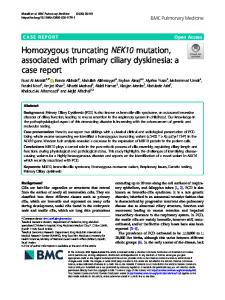Novel compound heterozygous DNAAF2 mutations cause primary ciliary dyskinesia in a Han Chinese family
- PDF / 4,816,483 Bytes
- 12 Pages / 595.276 x 790.866 pts Page_size
- 10 Downloads / 328 Views
GENETICS
Novel compound heterozygous DNAAF2 mutations cause primary ciliary dyskinesia in a Han Chinese family Minghan Sun 1,2 & Yi Zhang 3 & JiyunYang 3 & Yi Wang 2 & Hao Tan 1 & Hailian Wang 2 & Tiantian Lei 2 & Xiaojie Li 2 & Xiaojian Zhang 2 & Wen Xiong 2 & Ke Dou 2 & Yongxin Ma 1 Received: 8 December 2019 / Accepted: 10 June 2020 # Springer Science+Business Media, LLC, part of Springer Nature 2020
Abstract Purpose Primary ciliary dyskinesia (PCD), which commonly causes male infertility, is an inherited autosomal recessive disorder. This study aimed to investigate the clinical manifestations and screen mutations associated with the dynein axonemal assembly factor 2 (DNAAF2) gene in a Han Chinese family with PCD. Methods A three-generation family with PCD was recruited in this study. Eight family members underwent comprehensive medical examinations. Genomic DNA was extracted from the participants’ peripheral blood, and targeted next-generation sequencing technology was used to perform the mutation screening. The DNAAF2 expression was analyzed by immunostaining and Western blot. Results The proband exhibited the typical clinical features of PCD. Spermatozoa from the proband showed complete immotility but relatively high viability. Two novel compound heterozygous mutations in the DNAAF2 gene, c.C156A [p.Y52X] and c.C26A [p.S9X], were identified. Both nonsense mutations were detected in the proband, whereas the other unaffected family members carried either none or only one of the two mutations. The two nonsense heterozygous mutations were not detected in the 600 ethnically matched normal controls or in the Genome Aggregation Database. The defect of the DNAAF2 and the outer dynein arms and inner dynein arms were notably observed in the spermatozoa from the proband by immunostaining. Conclusion This study identified two novel compound heterozygous mutations of DNAAF2 leading to male infertility as a result of PCD in a Han Chinese family. The findings may enhance the understanding of the pathogenesis of PCD and improve reproductive genetic counseling in China. Keywords Primary ciliary dyskinesia (PCD) . male infertility . DNAAF2 mutation . spermatozoa
Introduction Primary ciliary dyskinesia (PCD) is an autosomal recessive disease with an estimated incidence of one in 10,000–20,000
live births worldwide, although its true prevalence may be even higher [1]. PCD patients commonly suffer from chronic sinusitis, bronchiectasis, neonatal respiratory distress, male infertility, and situs inversus, including the randomization of
Minghan Sun and Yi Zhang contributed equally to this work. Electronic supplementary material The online version of this article (https://doi.org/10.1007/s10815-020-01859-7) contains supplementary material, which is available to authorized users. * Ke Dou [email protected]
2
Central of Reproductive Medicine, Department of Obstetrics and Gynecology, Sichuan Academy of Medical Sciences and Sichuan Provincial People’s Hospital, School of Medicine, University of Electronic Science and Technology of Chi
Data Loading...











